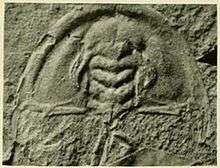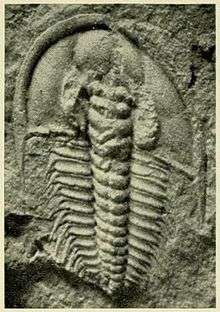Mummaspis
Mummaspis is an extinct genus from a well-known class of fossil marine arthropods, the trilobites, with five known species.[1] It lived during the early part of the Botomian stage, which lasted from approximately 524 to 518.5 million years ago. This faunal stage was part of the Cambrian Period.

Headshield of Mummaspis occidens, type specimen. U.S. National Museum, Catalogue No. 60080
| Mummaspis | |
|---|---|
 | |
| Mummaspis macer, (Type specimen), Fruitville, Lancaster County, Pennsylvania. U.S. National Museum, Catalogue No. 60092 | |
| Scientific classification | |
| Kingdom: | |
| Phylum: | |
| Class: | |
| Order: | |
| Suborder: | |
| Superfamily: | |
| Family: | "Laudoniidae" |
| Subfamily: | "Laudoniinae" |
| Genus: | Mummaspis Fritz, 1992 |
| species | |
| |
Taxonomy
Mummaspis is the genus closest to the common ancestor of Laudonia, the Biceratopsinae and the Bristoliinae. Including the species of Fritzolenellus, this clade is the sister group of Wanneria walcottana and the Holmiidae.[2]
Distribution
- M. occidens was collected in the Lower Cambrian (lower Olenellus-zone) of Alberta, Canada (Mural Formation, in the talus slope immediately West of Mumm Peak, and from the middle Mural Formation, 125 m above the base of that formation, just North of the Mount Robson Provincial Park boundary).
- M. truncatooculatus occurs in the Lower Cambrian (lower Olenellus-zone) of Alberta, Canada (Mural Formation, in the talus slope immediately West of Mumm Peak, and from the middle Mural Formation, 125 m above the base of that formation, just North of the Mount Robson Provincial Park boundary).
- M. oblisooculatus is found in the Lower Cambrian (Lower Olenellus-zone) of Alberta, Canada (Mural Formation, in the talus slope immediately West of Mumm Peak, and from the middle Mural Formation, 125 m above the base of that formation, just North of the Mount Robson Provincial Park boundary).
- M. muralensis is present in the Lower Cambrian (Lower Olenellus-zone) of Alberta, Canada (Mural Formation, in the talus slope immediately West of Mumm Peak, and from the middle Mural Formation, 125 m above the base of that formation, just North of the Mount Robson Provincial Park boundary).
- M. macer was extracted from the Lower Cambrian of Pennsylvania (middle Upper Olenellus-zone) (Kinzers Formation, 2 miles North of York, from Fruitville, 3 miles North of Lancaster, and ½ mile South of East-Petersburg.[1]
gollark: They'd also be stored in a dense binary format.
gollark: Messages would be compacted into chunks of 1MB or so each, which would then be compressed with zstandard.
gollark: I have various ideas for an ultradense Discord message packing format.
gollark: All the important and public ones are already linked, it seems.
gollark: The list fills my entire monitor, and contains a bunch of nonfunctional ones.
References
- Lieberman, B. S. (1999). "Systematic Revision of the Olenelloidea (Trilobita, Cambrian)" (PDF). Bulletin of the Peabody Museum of Natural History. 45.
- Lieberman, B.S. (1998). "Cladistic Analysis of the Early Cambrian Olenelloid Trilobites" (PDF). Journal of Paleontology. 72 (1): 59–78.
This article is issued from Wikipedia. The text is licensed under Creative Commons - Attribution - Sharealike. Additional terms may apply for the media files.